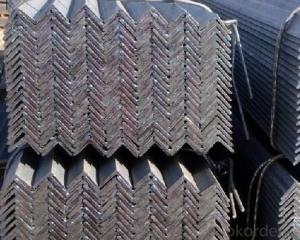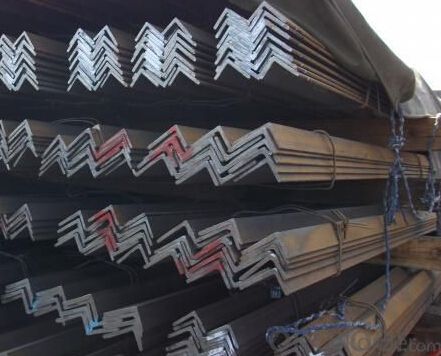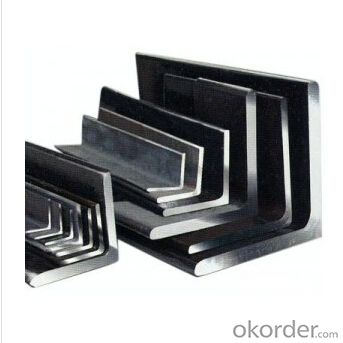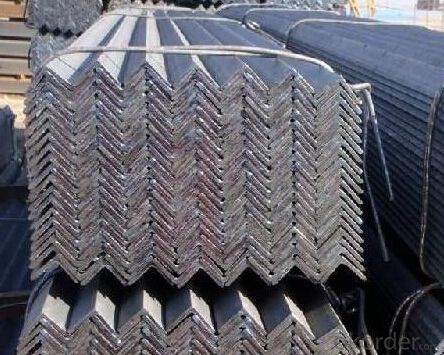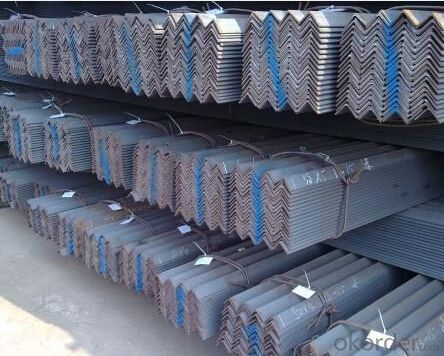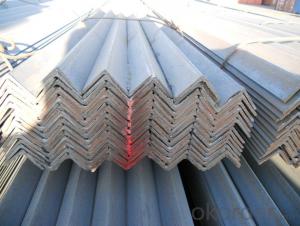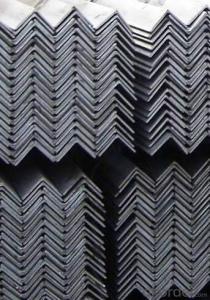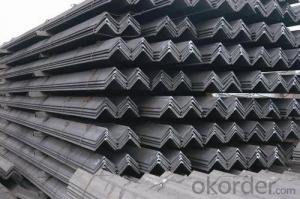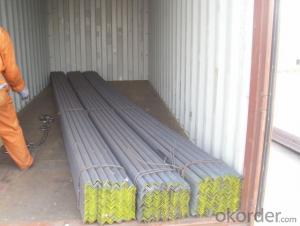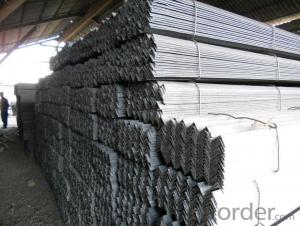Specifications of GB Q235 Equal Angle Steel or Uneual angle
- Loading Port:
- Tianjin
- Payment Terms:
- TT OR LC
- Min Order Qty:
- 100 m.t.
- Supply Capability:
- 10000 m.t./month
OKorder Service Pledge
OKorder Financial Service
You Might Also Like
1. Structure of Angle Steel Description
Angle steel has equal angle, unequal angle. Standards: GB,ASTM,BS,AISI,DIN,JIS Material:Material: GB Q235B, Q345B or Equivalent; ASTM A36; EN 10025, S235JR, S355JR; JIS G3192, SS400; SS540.
Sizes:
Sizes: 25mm-250mm | ||
a*t | ||
25*2.5-4.0 | 70*6.0-9.0 | 130*9.0-15 |
30*2.5-6.6 | 75*6.0-9.0 | 140*10-14 |
36*3.0-5.0 | 80*5.0-10 | 150*10-20 |
38*2.3-6.0 | 90*7.0-10 | 160*10-16 |
40*3.0-5.0 | 100*6.0-12 | 175*12-15 |
45*4.0-6.0 | 110*8.0-10 | 180*12-18 |
50*4.0-6.0 | 120*6.0-15 | 200*14-25 |
60*4.0-8.0 | 125*8.0-14 | 250*25 |
Material details:
Alloy No | Grade | Element (%) | |||||
C | Mn | S | P | Si | |||
|
|
|
|
|
|
| |
Q235 | B | 0.12—0.20 | 0.3—0.7 | ≤0.045 | ≤0.045 | ≤0.3 | |
|
|
|
|
|
|
| |
Alloy No | Grade | Yielding strength point( Mpa) | |||||
Thickness (mm) | |||||||
≤16 | >16--40 | >40--60 | >60--100 | ||||
≥ | |||||||
|
|
|
|
|
| ||
Q235 | B | 235 | 225 | 215 | 205 | ||
Alloy No | Grade | Tensile strength (Mpa) | Elongation after fracture (%) | ||||
Thickness (mm) | |||||||
| ≤16 | >16--40 | >40--60 | >60--100 | |||
≥ | |||||||
|
|
|
|
|
|
| |
Q235 | B | 375--500 | 26 | 25 | 24 | 23 | |
2.Main Features of angle steel
Broad-spectrum
High quantity
High strength
3.Usage & Applications of GB Q235 Angle Steel
Trusses
Transmission towers;
Telecommunication towers;
Bracing for general structures;
Stiffeners in structural use.
4.Packaging & Delivery of GB Q235 Angle Steel
Transportation: the goods are delivered by truck from mill to loading port, the maximum quantity can be loaded is around 40MTs by each truck. If the order quantity cannot reach the full truck loaded, the transportation cost per ton will be little higher than full load.With bundles and load in 20 feet/40 feet container, or by bulk cargo, also we could do as customer's request.
Marks:
Color mark: There will be color marking on both end of the bundle for the cargo delivered by bulk vessel. That makes it easily to distinguish at the destination port.
Tag mark: There will be tag mark tied up on the bundles. The information usually including supplier logo and name, product name, made in China, shipping marks and other information request by the customer.
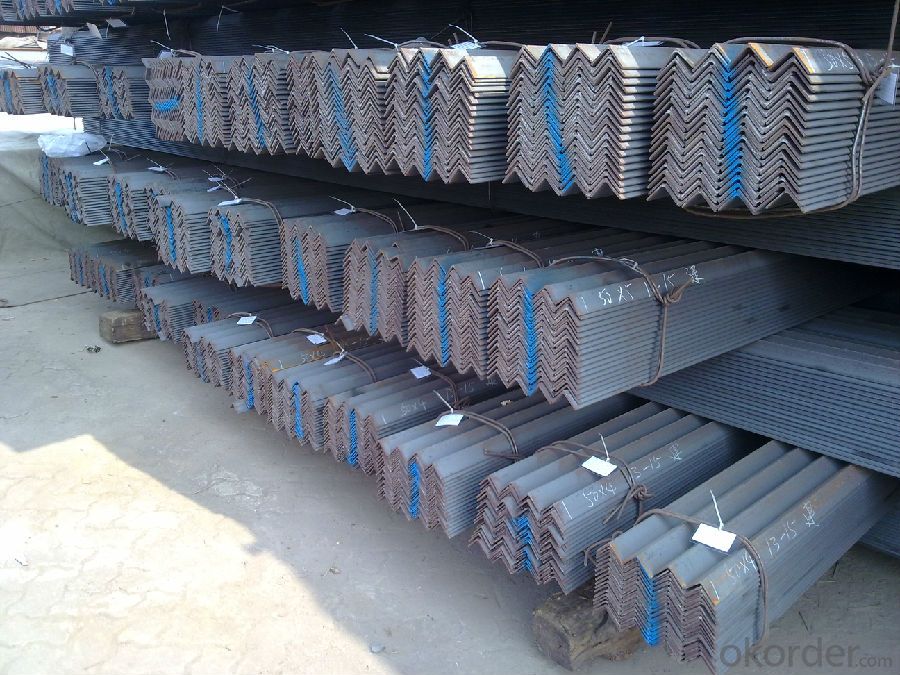
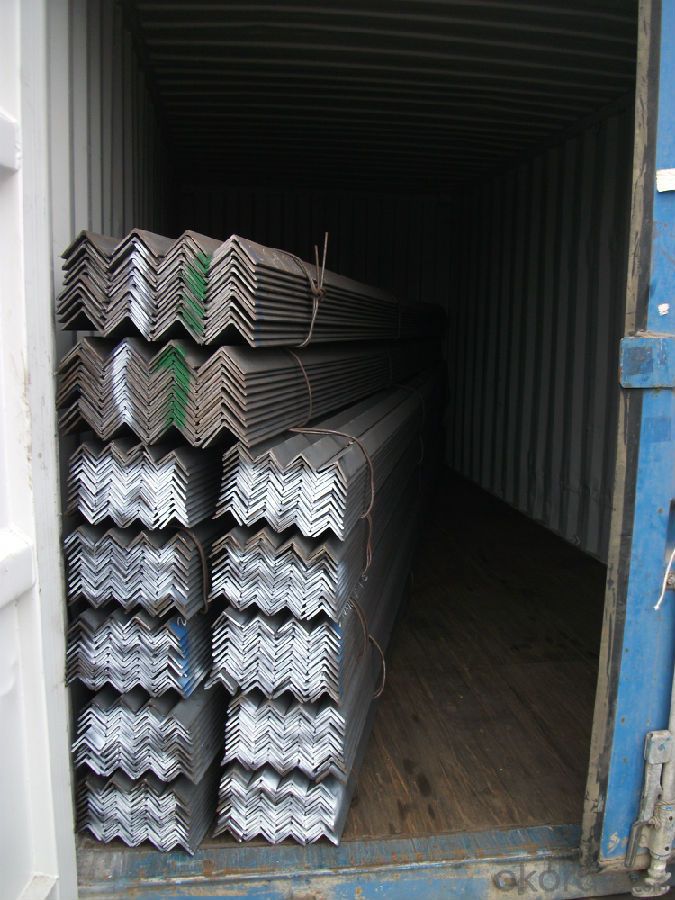
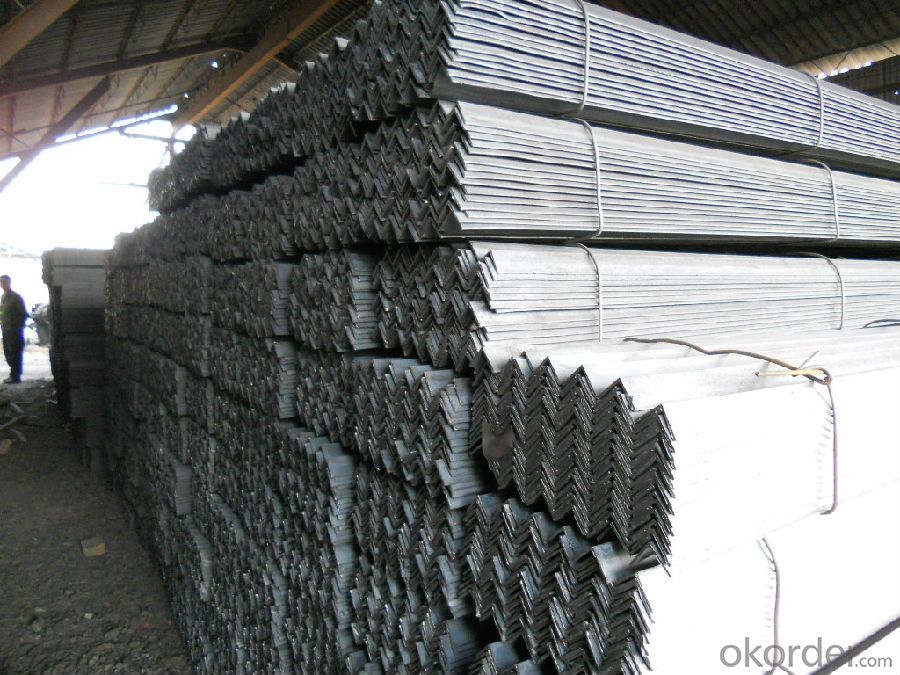
5.FAQ
We have organized several common questions for our clients,may help you sincerely:
①How about your company?
A world class manufacturer & supplier of castings forging in carbon steel and alloy steel,is one of the large-scale professional investment casting production bases in China,consisting of both casting foundry forging and machining factory. Annually more than 8000 tons Precision casting and forging parts are exported to markets in Europe,America and Japan. OEM casting and forging service available according to customer’s requirements.
②How to guarantee the quality of the products?
We have established the international advanced quality management system,every link from raw material to final product we have strict quality test;We resolutely put an end to unqualified products flowing into the market. At the same time, we will provide necessary follow-up service assurance.
③How long can we receive the product after purchase?
In the purchase of product within three working days, We will arrange the factory delivery as soon as possible. The pecific time of receiving is related to the state and position of customers.Commonly 7 to 10 working days can be served.
- Q: Do steel angles require maintenance?
- Maintenance is necessary for steel angles. Despite being durable, steel can still rust and corrode, especially when exposed to moisture or harsh environments. To prevent these problems and prolong the lifespan of steel angles, regular maintenance is required. Common maintenance practices include checking for rust or damage, cleaning the surface to remove dirt and debris, and applying protective coatings or paints to prevent corrosion. Proper storage and handling also play a role in maintaining steel angles. It is crucial to follow manufacturer instructions and seek advice from experts to determine the specific maintenance needs for steel angles in various applications.
- Q: How do you calculate the moment of resistance for a steel angle?
- When calculating the moment of resistance for a steel angle, one must take into account the properties of the angle section and its dimensions. The moment of resistance measures the angle's ability to resist bending. The moment of resistance can be calculated using the formula: Moment of Resistance = Plastic Section Modulus multiplied by Yield Strength of Steel The plastic section modulus can be determined using the following formula: Plastic Section Modulus = (Width multiplied by Thickness squared) divided by 6 In this equation, the width refers to the distance between the outer edges of the angle, while the thickness refers to the thickness of the angle section. The yield strength of the steel is a material property that can be obtained from its specification or reference material. It represents the maximum stress the steel can endure without experiencing permanent deformation. By substituting the values of the plastic section modulus and the yield strength of the steel into the formula for the moment of resistance, one can calculate the value. It is important to note that the dimensions used in the calculations should be in consistent units, such as millimeters or inches, depending on the units used for the yield strength value. This calculation provides an estimation of the moment of resistance for a steel angle and is valuable in structural engineering applications for determining the angle section's capacity under bending loads.
- Q: How do you calculate the bending moment of a loaded steel angle?
- To calculate the bending moment of a loaded steel angle, you need to consider the applied load, the moment arm, and the cross-sectional properties of the angle. First, determine the applied load acting on the steel angle. This could be a point load or a distributed load, depending on the specific situation. Next, locate the point of application of the load and determine the moment arm. The moment arm is the perpendicular distance between the point of application of the load and the axis of rotation. Once you have the applied load and the moment arm, you can calculate the bending moment using the formula: Bending Moment = Applied Load x Moment Arm Finally, you need to consider the cross-sectional properties of the steel angle. These include the area moment of inertia (I) and the section modulus (Z). The area moment of inertia measures the resistance to bending and depends on the shape and dimensions of the angle. The section modulus represents the strength of the section and is calculated as the ratio of the area moment of inertia to the distance from the centroid to the extreme fiber. By using the appropriate equations and considering the cross-sectional properties, you can determine the bending moment capacity of the loaded steel angle and assess its structural integrity under the given load conditions.
- Q: What are the advantages of using steel angles over other materials?
- There are several advantages of using steel angles over other materials. Firstly, steel angles are known for their superior strength and durability. Steel is a highly robust material that can withstand heavy loads and extreme weather conditions. This makes steel angles ideal for structural applications where strength and stability are crucial, such as in building construction and bridge supports. Secondly, steel angles offer excellent versatility in design and fabrication. They can be easily cut, welded, and formed into various shapes and sizes, allowing for customized solutions that meet specific project requirements. This adaptability makes steel angles suitable for a wide range of applications, including frameworks, support brackets, and reinforcements. Furthermore, steel angles have a high resistance to corrosion. Steel is inherently resistant to rusting and can be further protected through various coatings or galvanization processes. This corrosion resistance ensures the longevity and low maintenance of steel angles, making them a cost-effective choice in the long run. Additionally, steel angles offer a high degree of fire resistance. Steel does not burn or contribute to the spread of fire, which is particularly important in applications where fire safety is a concern, such as in building structures or industrial facilities. Lastly, steel angles are readily available and cost-effective. Steel is one of the most widely used materials in the construction industry and is readily available in various sizes and grades. The abundance of steel makes it a cost-effective option, especially when compared to alternative materials that may have limited availability or higher manufacturing costs. In summary, the advantages of using steel angles include their strength, versatility, corrosion resistance, fire resistance, and cost-effectiveness. These qualities make steel angles a preferred choice for many construction and structural applications.
- Q: How do you design bracing using steel angles?
- Designing bracing using steel angles involves determining the required strength and stiffness of the bracing members, selecting appropriate steel angles based on their load-bearing capacities, and arranging them in a configuration that effectively resists the applied forces and moments. The design process typically includes analyzing the structure's loadings, determining the required bracing forces, calculating the required cross-sectional area of the steel angles, and verifying the design against relevant design codes and standards. Additionally, considerations such as connection details and fabrication constraints also play a role in designing bracing using steel angles.
- Q: What is the purpose of using steel angles in construction?
- Steel angles are commonly used in construction for several purposes. The primary purpose of using steel angles is to provide structural support and stability to various components of a building or structure. These angles are often used to reinforce corners, edges, and joints, adding strength and rigidity to the overall structure. Additionally, steel angles are used to distribute and transfer loads or forces within the construction. They help to evenly distribute the weight and stress across different parts of the structure, preventing any concentrated points of weakness. Moreover, steel angles are versatile and can be easily customized and fabricated to meet specific construction requirements. They can be cut, drilled, and welded, allowing for seamless integration into a wide range of construction projects. Furthermore, steel angles offer excellent durability and resistance to corrosion, making them suitable for both indoor and outdoor applications. They can withstand heavy loads, extreme weather conditions, and provide long-lasting support to the structure. In summary, the purpose of using steel angles in construction is to enhance the structural integrity, provide support and stability, distribute loads, and ensure the longevity of the building or structure.
- Q: How many meters is one angle steel?
- Standard Specification for hot-rolled equal angle iron is 2#-20#. The angle iron can be made up of different force components according to the different structure, and can also be used as the connecting piece between the components. Widely used in a variety of architectural and engineering structures, such as beams, bridges, towers, hoisting and conveying machinery, ships, industrial furnace, reaction tower, container frame and warehouse.
- Q: What is the maximum allowable bearing stress for a steel angle?
- The maximum bearing stress that a steel angle can withstand depends on several factors, including the type of steel, angle thickness and size, and specific application or design requirements. Generally, the maximum bearing stress is determined by assessing the angle's structural strength and stability under expected load conditions. To ascertain the maximum bearing stress for a steel angle, it is vital to refer to relevant industry standards, such as the specifications provided by the American Institute of Steel Construction (AISC) or the Eurocode design standards. These standards offer guidelines and formulas to calculate the maximum bearing stress based on the angle's properties and load factors. Moreover, factors like the presence of additional reinforcements, corrosion or surface imperfections, and the method of connection or support can also impact the maximum bearing stress. Hence, it is crucial to consult the appropriate design codes and seek advice from a structural engineer or steel design expert in order to accurately determine the maximum allowable bearing stress for a specific steel angle in a given application.
- Q: Can steel angles be used for vehicle frames?
- Yes, steel angles can be used for vehicle frames. Steel angles are commonly used in the construction industry for their structural strength and versatility. They have a wide range of applications, including the construction of vehicle frames. Steel angles provide excellent support and stability, making them ideal for bearing heavy loads and withstanding the various stresses and forces experienced by a vehicle during operation. Additionally, steel angles can be easily welded or bolted together, allowing for flexibility in the design and construction of vehicle frames. Overall, steel angles are a reliable and durable choice for vehicle frames, ensuring the structural integrity and safety of the vehicle.
- Q: Are steel angles suitable for mezzanine floors?
- Indeed, steel angles prove to be a fitting choice for constructing mezzanine floors. Their robustness, longevity, and affordability render them a prevalent choice in mezzanine floor construction. By delivering structural reinforcement and steadiness, steel angles facilitate the expansion of floor area. Their fabrication and installation are straightforward, thus contributing to their widespread adoption in the creation of mezzanine floors. Not only can they endure substantial loads, but they also provide a solid foundation for diverse applications, such as storage, offices, or supplementary workspaces. Furthermore, steel angles can be tailored to meet specific design prerequisites, showcasing their versatility as a prime option for mezzanine floor construction.
Send your message to us
Specifications of GB Q235 Equal Angle Steel or Uneual angle
- Loading Port:
- Tianjin
- Payment Terms:
- TT OR LC
- Min Order Qty:
- 100 m.t.
- Supply Capability:
- 10000 m.t./month
OKorder Service Pledge
OKorder Financial Service
Similar products
Hot products
Hot Searches
Related keywords
